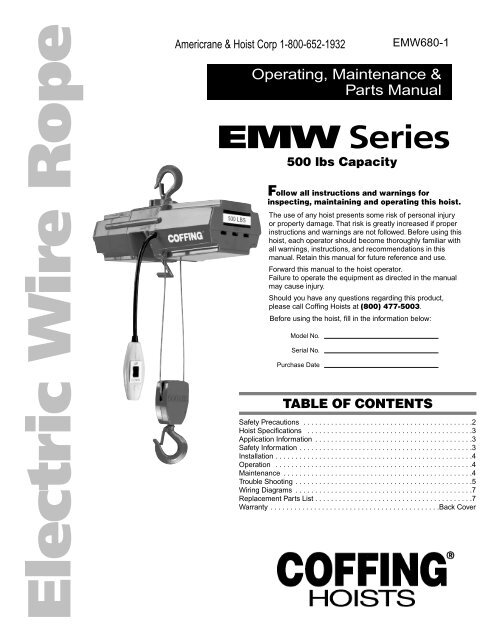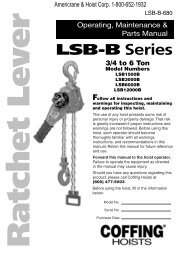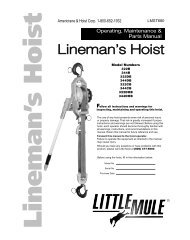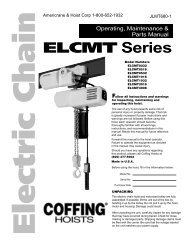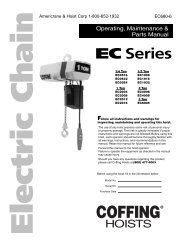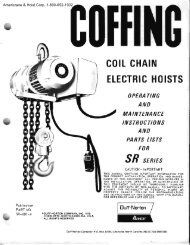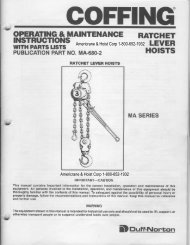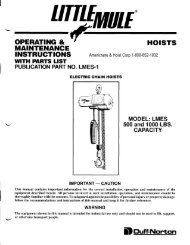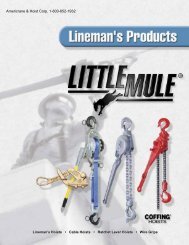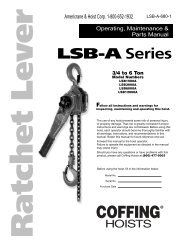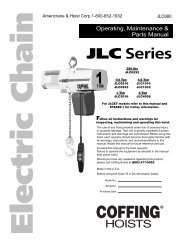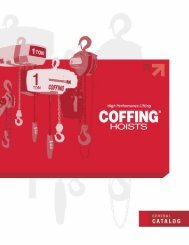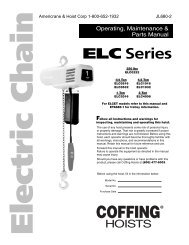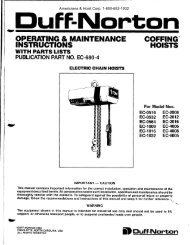EMW Series - Coffing Hoists, Coffing Hoist Parts
EMW Series - Coffing Hoists, Coffing Hoist Parts
EMW Series - Coffing Hoists, Coffing Hoist Parts
You also want an ePaper? Increase the reach of your titles
YUMPU automatically turns print PDFs into web optimized ePapers that Google loves.
Electric Wire Rope<br />
Americrane & <strong>Hoist</strong> Corp 1-800-652-1932<br />
<strong>EMW</strong>680-1<br />
Operating, Maintenance &<br />
<strong>Parts</strong> Manual<br />
<strong>EMW</strong> <strong>Series</strong><br />
500 lbs Capacity<br />
Follow all instructions and warnings for<br />
inspecting, maintaining and operating this hoist.<br />
The use of any hoist presents some risk of personal injury<br />
or property damage. That risk is greatly increased if proper<br />
instructions and warnings are not followed. Before using this<br />
hoist, each operator should become thoroughly familiar with<br />
all warnings, instructions, and recommendations in this<br />
manual. Retain this manual for future reference and use.<br />
Forward this manual to the hoist operator.<br />
Failure to operate the equipment as directed in the manual<br />
may cause injury.<br />
Should you have any questions regarding this product,<br />
please call <strong>Coffing</strong> <strong><strong>Hoist</strong>s</strong> at (800) 477-5003.<br />
Before using the hoist, fill in the information below:<br />
Model No.<br />
Serial No.<br />
Purchase Date<br />
TABLE OF CONTENTS<br />
Safety Precautions . . . . . . . . . . . . . . . . . . . . . . . . . . . . . . . . . . . . . . . . . . .2<br />
<strong>Hoist</strong> Specifications . . . . . . . . . . . . . . . . . . . . . . . . . . . . . . . . . . . . . . . . . .3<br />
Application Information . . . . . . . . . . . . . . . . . . . . . . . . . . . . . . . . . . . . . . . .3<br />
Safety Information . . . . . . . . . . . . . . . . . . . . . . . . . . . . . . . . . . . . . . . . . . . .3<br />
Installation . . . . . . . . . . . . . . . . . . . . . . . . . . . . . . . . . . . . . . . . . . . . . . . . . .4<br />
Operation . . . . . . . . . . . . . . . . . . . . . . . . . . . . . . . . . . . . . . . . . . . . . . . . . .4<br />
Maintenance . . . . . . . . . . . . . . . . . . . . . . . . . . . . . . . . . . . . . . . . . . . . . . . .4<br />
Trouble Shooting . . . . . . . . . . . . . . . . . . . . . . . . . . . . . . . . . . . . . . . . . . . . .5<br />
Wiring Diagrams . . . . . . . . . . . . . . . . . . . . . . . . . . . . . . . . . . . . . . . . . . . . .7<br />
Replacement <strong>Parts</strong> List . . . . . . . . . . . . . . . . . . . . . . . . . . . . . . . . . . . . . . . .7<br />
Warranty . . . . . . . . . . . . . . . . . . . . . . . . . . . . . . . . . . . . . . . . . . .Back Cover
Country Club Road<br />
P.O. Box 779<br />
Wadesboro, NC 28170 USA<br />
TEL: (800) 477-5003<br />
FAX: (800) 374-6853<br />
SAFETY PRECAUTIONS<br />
Each <strong>Coffing</strong> <strong>EMW</strong> series wire rope hoist is built in accordance<br />
with the specifications contained herein and at the time of<br />
manufacture complies with our interpretation of applicable<br />
sections of *American Society of Mechanical Engineers Code<br />
(ASME) B30.16 “Overhead <strong><strong>Hoist</strong>s</strong>,” the National Electrical Code<br />
(ANSI/NFPA 70) and the Occupational Safety and Health Act<br />
(OSHA). Since OSHA states the National Electrical Code applies<br />
to all electric hoists, installers are required to provide current<br />
overload protection and grounding on the branch circuit section in<br />
keeping with the code. Check each installation for compliance with<br />
the application, operation and maintenance sections of these<br />
articles.<br />
*Copies of this Standard can be obtained from ASME Order<br />
Department, 22 Law Drive, Box 2300, Fairfield, NJ 07007-2300,<br />
U.S.A.<br />
Improper operation of a hoist can create a potentially<br />
hazardous situation which, if not avoided, could result<br />
in death or serious injury. To avoid such a potentially<br />
hazardous situation, THE OPERATOR SHALL:<br />
1. NOT operate a damaged, malfunctioning or unusually<br />
performing hoist.<br />
2. NOT operate the hoist until you have thoroughly read and<br />
understood the manufacturer’s Operating and Maintenance<br />
Instructions or Manuals.<br />
3. NOT operate a hoist which has been modified without the<br />
manufacturer’s approval or without certification that it is in<br />
conformity with ANSI/ASME B30 volumes.<br />
4. NOT lift more than rated load for the hoist.<br />
5. NOT use hoist with twisted, kinked, damaged, or worn wire rope.<br />
6. NOT use the hoist to lift, support, or transport people.<br />
7. NOT lift loads over people.<br />
8. NOT operate a hoist unless all persons are and remain clear of<br />
the supported load.<br />
9. NOT operate unless load is centered under hoist.<br />
10. NOT attempt to lengthen the wire rope or repair damaged<br />
wire rope.<br />
11. Protect the hoist’s wire rope from weld splatter or other damaging<br />
contaminants.<br />
12. NOT operate hoist when it is restricted from forming a straight<br />
line from hook to hook in the direction of loading.<br />
13. NOT use wire rope as a sling, or wrap wire rope<br />
around load.<br />
14. NOT apply the load to the tip of the hook or to the hook latch.<br />
15. NOT apply load unless wire rope is properly seated in its<br />
groove(s).<br />
16. NOT apply load if bearing prevents equal loading on all load<br />
supporting ropes.<br />
17. NOT operate beyond the limits of the wire rope.<br />
18. NOT leave load supported by the hoist unattended unless<br />
specific precautions have been taken.<br />
Americrane & <strong>Hoist</strong> Corp 1-800-652-1932<br />
2<br />
19. NOT allow the wire rope or hook to be used as an electrical or<br />
welding ground.<br />
20. NOT allow the wire rope or hook to be touched by a live<br />
welding electrode.<br />
21. NOT remove or obscure the warnings on the hoist.<br />
22. NOT operate a hoist on which the safety placards or decals are<br />
missing or illegible.<br />
23. NOT operate a hoist unless it has been securely attached to a<br />
suitable support.<br />
24. NOT operate a hoist unless load slings or other approved single<br />
attachments are properly sized and seated in the hook saddle.<br />
25. Take up slack carefully - make sure load is balanced and load<br />
holding action is secure before continuing.<br />
26. Shut down a hoist that malfunctions or performs unusually and<br />
report such malfunction.<br />
27. Make sure hoist limit switches function properly.<br />
28. Warn personnel of an approaching load.<br />
Improper operation of a hoist can create a potentially<br />
hazardous situation which, if not avoided, could result<br />
in minor or moderate injury. To avoid such a potentially<br />
hazardous situation, THE OPERATOR SHALL:<br />
1. Maintain firm footing or be otherwise secured when operating<br />
the hoist.<br />
2. Check brake function by tensioning the hoist prior to each<br />
lift operation.<br />
3. Use hook latches. Latches are to retain slings, chains, etc. under<br />
slack conditions only.<br />
4. Make sure the hook latches are closed and not supporting any<br />
parts of the load.<br />
5. Make sure the load is free to move and will clear all obstructions.<br />
6. Avoid swinging the load or hook.<br />
7. Make sure hook travel is in the same direction as shown on<br />
the controls.<br />
8. Inspect the hoist regularly, replace damaged or worn parts, and<br />
keep appropriate records of maintenance.<br />
9. Use the hoist manufacturer’s recommended parts when repairing<br />
the unit.<br />
10. Lubricate wire rope per hoist manufacturer’s recommendations.<br />
11. NOT use the hoist load limiting or warning device to measure load.<br />
12. NOT use limit switches as routine operating stops. They are<br />
emergency devices only.<br />
13. NOT allow your attention to be diverted from operating<br />
the hoist.<br />
14. NOT allow the hoist to be subjected to sharp contact with other<br />
hoists, structures, or objects through misuse.<br />
15. NOT adjust or repair the hoist unless qualified to perform such<br />
adjustments or repairs.
Americrane & <strong>Hoist</strong> Corp 1-800-652-1932<br />
HOIST SPECIFICATIONS<br />
<strong>Coffing</strong> <strong>EMW</strong> series electric hoists are compact wire rope<br />
hoists designed for a variety of light duty applications. The<br />
<strong>EMW</strong> is constructed of lightweight aluminum housings to<br />
provide strength and portability, weighing less than 25 lbs.<br />
Other features include; thermally protected motors, swivel top<br />
suspension, upper paddle limit switch to regulate load travel,<br />
quick acting electromagnetic brake for positive load control and<br />
thermal motor protection to prevent overheating. As a standard,<br />
hooks are supplied with safety latches.<br />
<strong>Coffing</strong> <strong>EMW</strong> series hoists are designed and tested in<br />
accordance with the American Society of Mechanical<br />
Engineers Code B30.16, “Safety Standard for Overhead<br />
<strong><strong>Hoist</strong>s</strong>.” <strong>Coffing</strong> <strong>EMW</strong> series hoists are built in compliance with<br />
UL, file number SA 5247. Made in U.S.A.<br />
Failure to comply with Safety Precautions outlined<br />
throughout this manual can result in serious injuries<br />
or death. Before using this hoist, each operator<br />
should become thoroughly familiar with all warnings,<br />
instructions and recommendations in this manual.<br />
APPLICATION INFORMATION<br />
This hoist is intended for lifting freely suspended (unguided)<br />
loads weighing no more than 500 pounds. This hoist is not<br />
intended for industrial or production applications requiring<br />
continuous operation, it should only be used on an intermittent<br />
basis. <strong>Coffing</strong> <strong><strong>Hoist</strong>s</strong> cannot be responsible for applications other<br />
than those for which <strong>Coffing</strong> equipment is recommended. Prior<br />
to installation and operation, we caution the user to review his<br />
application for abnormal environmental or handling conditions<br />
and to observe the applicable recommendations as follows:<br />
ADVERSE ENVIRONMENTAL CONDITIONS<br />
Do not use the hoist in uncovered outdoor locations, areas<br />
containing flammable vapors, liquids, gases or any combustible<br />
dusts or fibers. Refer to Article 500 of the National Electrical<br />
Code. Do not use this hoist in highly corrosive, abrasive or wet<br />
environments. Do not use this hoist in applications involving<br />
extended exposure to ambient temperatures below -10°F or<br />
above 130°F.<br />
LIFTING OF HAZARDOUS LOADS<br />
This hoist is not recommended for use in lifting or transporting<br />
hazardous loads or materials which could cause widespread<br />
damage if dropped. The lifting of loads which could explode or<br />
create chemical or radioactive contamination if dropped<br />
requires fail-safe redundant supporting devices which are not<br />
incorporated into this hoist.<br />
Table 1 - Basic Specifications<br />
3<br />
Country Club Road<br />
P.O. Box 779<br />
Wadesboro, NC 28170 USA<br />
TEL: (800) 477-5003<br />
FAX: (800) 374-6853<br />
LIFTING OF GUIDED LOADS<br />
This hoist is not recommended for use in the lifting of guided<br />
loads, including dumbwaiters and elevators. Such applications<br />
require additional protective devices which are not incorporated<br />
into this hoist. For such applications, refer to the requirements<br />
of applicable state and local codes, and the American National<br />
Safety Code for elevators, dumbwaiters, escalators and moving<br />
walks (ASME A17.1).<br />
SAFETY INFORMATION<br />
1. Follow all local electrical and safety codes, as well as the<br />
National Electrical Code (NEC) and the Occupational<br />
Safety and Health Act (OSHA) in the United States.<br />
2. <strong>Hoist</strong> must be securely and adequately grounded.<br />
3. Be careful when touching the exterior of an operating<br />
motor; it may be hot enough to be painful or cause injury.<br />
With modern motors this condition is normal if operated at<br />
rated load and voltage (modern motors are built to operate<br />
at higher temperatures).<br />
4. Protect the power cable and control cable from coming in<br />
contact with sharp objects.<br />
5. Do not kink power cable and control cable and never allow<br />
the cable to come in contact with oil, grease, hot surfaces,<br />
or chemicals.<br />
6. Make certain that the power source conforms to the<br />
requirements of your equipment.<br />
7. Inspect the unit daily before operating hoist.<br />
8. Cluttered areas and benches invite accidents.<br />
9. The operator should not engage in any practice which will<br />
divert his attention while operating the hoist.<br />
10. Before using the hoist, the operator should be certain that<br />
all personnel are clear.<br />
11. Do not operate hoist with loads exceeding its rated capacity.<br />
12. Supporting frames or beams used as a hoist hanger must<br />
have a greater load capacity than the hoist.<br />
13. Do not attempt to operate hoist beyond normal maximum<br />
lift range.<br />
14. Align hoist for a straight line pull. Avoid side pull or end pull.<br />
15. Do not operate hoist with twisted or damaged wire rope.<br />
16. Do not operate a damaged or malfunctioning hoist until<br />
necessary adjustments or repairs have been made.<br />
17. Do not use hoist to lift people or to carry loads over people.<br />
18. Do not leave a load suspended in the air unattended.<br />
19. Always remove load before making repairs.<br />
20. Do not remove or obscure capacity or warning decals.<br />
Lifting Max. Horse- Duty PB Cord Power Cord Overall Net<br />
Model Rated Power Speed Lift power Head- Cycle Length Limit Length Amp Dia. Wt.<br />
No. Capacity Supply (fpm) (ft) (hp) room Max. (in) Switches (in) Draw (in) (lb)<br />
<strong>EMW</strong>500C 500 115 volts, 10 10 1/6 14½ 10 Minutes 6 Upper 13 3 amps 4 5 /8 H x 21<br />
1-Phase per hour Paddle 6 W x<br />
60 Hz 14½ L
Country Club Road<br />
P.O. Box 779<br />
Wadesboro, NC 28170 USA<br />
TEL: (800) 477-5003<br />
FAX: (800) 374-6853<br />
INSTALLATION<br />
1. Before installing the hoist, check the following:<br />
a. Make sure all supporting structures and attaching devices<br />
are strong enough to hold your intended loads. If in doubt,<br />
consult a qualified structural engineer.<br />
b. This hoist is equipped with a 3-prong, grounding-type plug<br />
to minimize shock hazards. It must be plugged into a<br />
properly installed and grounded receptacle to maintain<br />
this protection.<br />
c. This hoist is intended for use on a 115 volt, single-phase,<br />
60 Hz power supply. The power supply should be plus or<br />
minus 10% of 115 volts.<br />
d. Installation area must provide operating conditions for the<br />
operator including sufficient room for the operator and<br />
other personnel to stand clear of the load at all times.<br />
e. Make sure that the hook latch closes after hanging the hoist.<br />
Always disconnect power source before working on<br />
or near a hoist or its connected load. If the power<br />
disconnect point is out of sight, lock it in the open<br />
position and tag to prevent unexpected application<br />
of power.<br />
2. Before operating the hoist, be sure to observe the following:<br />
a. ALWAYS DISCONNECT HOIST FROM POWER SUPPLY<br />
before removing electrical cover or when making any<br />
electrical connection in the hoist or pushbutton station.<br />
b. Limit Switch Operation. Before placing the hoist in<br />
operation, check for proper upper limit switch operation.<br />
Push the “UP” button, and while the hook is moving<br />
upward, raise the limit switch paddle (Figure 2, Item 35).<br />
The hook should stop immediately. Do not operate the<br />
hoist if the limit switch is not operating properly.<br />
c. Brake Operation. NOTE: Run the hoist with a light load a<br />
few times before lifting the rated load. After lifting a light<br />
load a few times, test the hoist by lifting the rated load.<br />
Check for load hook drift with rated load on the hook. If<br />
hook does not stop within one to two inches when<br />
pushbutton is released, it may be necessary to replace<br />
the brake assembly.<br />
OPERATION<br />
This hoist is designed for safe operation within the limits of its<br />
rated capacity. It is controlled by the “UP” and “DOWN” buttons<br />
of the pushbutton station. Although the <strong>Coffing</strong> <strong>EMW</strong> is built<br />
with many features to ensure safety, it is a requirement that a<br />
hoist operator understands safe lifting practices. The following<br />
points must be observed.<br />
1. Do not overload the hoist.<br />
2. Align hoist directly over load. Do not make extreme side<br />
pulls with the hoist.<br />
3. Operate the hoist only in a hanging position with<br />
adequate support.<br />
4. Do not “sling” the load hook and wire rope around the load.<br />
Use an approved sling.<br />
Americrane & <strong>Hoist</strong> Corp 1-800-652-1932<br />
4<br />
5. Be sure there are no twists or kinks in the wire rope as it<br />
travels into the hoist housing.<br />
6. Lift the load just clear of its supports and stop the hoist to<br />
check for proper brake action.<br />
7. Do not stand beneath a load! Do not move a load in such a<br />
manner as to endanger personnel.<br />
8. Don’t lower into areas where visibility is obscured unless<br />
someone else is guiding the operation.<br />
9. Use common sense at all times when operating a hoist.<br />
10. Do not run hook down so that fewer than two wraps of<br />
cable remain on drum.<br />
11. Lift and lower the load smoothly, avoiding jogging of the<br />
controls or quick reversals.<br />
12. Do not reverse wind cable on drum. If hoist runs in direction<br />
opposite that indicated on pushbutton, cable may be<br />
reverse wound. If this situation occurs, cease using hoist<br />
immediately. Rewind cable in proper direction and inspect<br />
hoist for damage.<br />
13. Do not operate damaged or malfunctioning hoist.<br />
14. The limit switch is an emergency protective device. Do not<br />
use the limit switch to stop the hoist in normal operation.<br />
MAINTENANCE<br />
INSPECTIONS<br />
A planned inspection routine should be established for this<br />
hoist based upon frequency of use, severity of use, and<br />
environmental conditions (Reference ASME Standard B30.16).<br />
All inspections should be performed or overseen by a<br />
designated inspector. Special inspections should be made<br />
following any significant repairs and if the hoist is used more<br />
than 40 hours per week, under adverse environmental<br />
conditions or any operating occurrence leading one to suspect<br />
that the hoist’s capability may have been impaired.<br />
1. Daily Inspection. Inspect the following items daily before<br />
operating the hoist.<br />
a. Check pushbutton station, brake, and limit switch for<br />
proper operation (See INSTALLATION, 2-b & 2-c).<br />
b. Check hooks for deformation, cracks, or chemical<br />
damage. Hooks having more than 1" throat opening<br />
should be replaced, (See Figure 1, page 5).<br />
c. Check for bent or otherwise damaged hook latches.<br />
d. Check wire rope for wear, broken wires, kinks or twists.<br />
e. Check pushbutton cord and power cord for cuts or damage.<br />
2. Quarterly Inspection. Inspect the following items at 90-day<br />
intervals.<br />
a. Check all items under daily inspection.<br />
b. Check for loose bolts, screws and nuts.<br />
c. Inspect for worn, corroded, cracked or distorted parts.<br />
d. Check electrical parts, limit switch and pushbutton station.<br />
3. Annual Inspection. Inspect the following items annually.<br />
a. Check all items under daily and quarterly inspection.<br />
b. Check hooks for cracks by means of a magnetic particle<br />
test or other crack detecting test.
HOOKS<br />
Refer to Figure 1.<br />
1. Inspect hooks once daily for cracking, extreme wear or<br />
spreading. Replace hooks showing any of these signs. If the<br />
throat openings are spread wider than the maximum<br />
permissible 15% increase listed here, the hooks have been<br />
overstressed and must be replaced. Any hook that is bent or<br />
twisted more than 10 degrees from the plane of an unbent<br />
hook must also be replaced.<br />
Normal “X” Reject “X”<br />
29/32" 1 1 /16"<br />
Figure 1 — Hook<br />
Inspection<br />
2. The hook latches should be inspected to ensure that they<br />
close the hook throat opening in a secure manner when a<br />
load is applied. On the top hook, the hook collar should be<br />
fully restrained by the retaining pin.<br />
WIRE ROPE<br />
Refer to Figure 2.<br />
To remove the wire rope, loosen the setscrew (49). Remove<br />
worn cable assembly (17) by pulling the cable from the drum<br />
(4), through the cable guide (32) and the sheave (6), and<br />
through the top of the suspension frame (1) after removing the<br />
plug (47). NOTE: The bottom block (5) should be disassembled<br />
by removing the two screws (44) for the installation of the<br />
new cable.<br />
Americrane & <strong>Hoist</strong> Corp 1-800-652-1932<br />
5<br />
Country Club Road<br />
P.O. Box 779<br />
Wadesboro, NC 28170 USA<br />
TEL: (800) 477-5003<br />
FAX: (800) 374-6853<br />
To install the new cable, insert the plain end of the cable<br />
assembly through the opening in the suspension frame (1) and<br />
pull the cable through the frame until swaged ball is seated in<br />
the frame. Replace the plug (47) in top of the frame. Reeve the<br />
cable around the sheave (6) and assemble the bottom block (5)<br />
with the two screws (44). Position the drum as shown in Figure<br />
2 and push the cable through the guide (32) and through the<br />
top opening in the drum and back through the bottom opening<br />
in the drum. While holding the cable in place, tighten the<br />
setscrew (49) to 25 in. lbs. torque.<br />
LUBRICATION<br />
Keep brake surface and brake lining free of grease.<br />
Proper lubrication is necessary for a long and relatively troublefree<br />
hoist operation.<br />
Wire Rope<br />
Wipe clean with a clean cloth periodically and apply a light coat<br />
of oil.<br />
Drum<br />
Apply a small amount of grease to drum shaft bearings (See<br />
Figure 2, Ref. No. 39).<br />
Gears<br />
The gear housing is adequately lubricated at assembly with 1/3<br />
pound of NLGI #1 grease. If relubrication becomes necessary,<br />
use approximately 3/4 cup of light, semi-fluid grease.<br />
Idler Shaft<br />
TROUBLE SHOOTING<br />
Apply a small amount of grease to the bore of the idler sheave<br />
(See Figure 2, Ref. No. 6) in the bottom block.<br />
Always disconnect unit from the power supply system before removing hoist covers or the back cover of control station.<br />
––– Probable Cause ––– ––– Remedy–––<br />
<strong>Hoist</strong> cuts off after several minutes of operation, but Thermal protector opening due to excessive duty.<br />
will run again after several minutes Reduce duty cycle.<br />
Brake will not hold, load drifts down. Brake worn out or oil contaminated. Replace brake<br />
assembly.<br />
Brake chatters Check for gap greater than .010". Check rectifier for<br />
open or shorted legs.<br />
<strong>Hoist</strong> runs in wrong direction when pushbutton is operated. Check drum for reverse-wound cable. If cable is<br />
reverse-wound, run cable off of drum and back on<br />
in proper direction. Check for damage to cable guide,<br />
limit switch and drum area of hoist which may have<br />
resulted from reverse winding.
57<br />
55<br />
56<br />
42 43<br />
2<br />
31<br />
53<br />
30<br />
42<br />
43<br />
52<br />
34<br />
37<br />
44<br />
46<br />
Figure 2 - <strong>EMW</strong> Exploded View<br />
53<br />
36<br />
14<br />
50<br />
51<br />
21<br />
5<br />
17<br />
20<br />
20<br />
33<br />
39<br />
19<br />
48<br />
59<br />
35<br />
14<br />
4<br />
Americrane & <strong>Hoist</strong> Corp 1-800-652-1932<br />
18<br />
47<br />
1<br />
29<br />
29<br />
32<br />
69<br />
6<br />
45<br />
49<br />
14<br />
5<br />
48<br />
44<br />
16<br />
23<br />
27<br />
25<br />
54<br />
24 28<br />
28<br />
6<br />
26<br />
15 3814<br />
41<br />
38<br />
13 11 10 13<br />
38 8<br />
12 13<br />
37 38<br />
9 38 13 7<br />
60<br />
13 38<br />
3<br />
38 1338<br />
43 42<br />
61<br />
67<br />
50<br />
68<br />
66<br />
65 62<br />
63<br />
64<br />
56<br />
64
<strong>Parts</strong> List for <strong>EMW</strong> Exploded View<br />
Ref Description Part Qty Ref Description Part Qty<br />
No. No. No. No.<br />
1 Suspension Frame 33K4-5 1<br />
2 Control Cover 36K9-2 1<br />
3 Transmission Cover 35K4 1<br />
4 Drum 16K4 1<br />
5 Bottom Block Frame 30K4 2<br />
6 Sheave 28K4 1<br />
7 High Speed Pinion 400K8 1<br />
8 High Speed Cluster Gear 406K1 1<br />
9 Intermediate Cluster Gear 406K2 1<br />
10 Intermediate Gear 403K10 1<br />
11 Output Pinion 404K6 1<br />
12 Output Gear 405K5 1<br />
13 Thrust Washer 255K1 6<br />
14 Thrust Washer 255K2 4<br />
15 Drum Shaft 132KG6 1<br />
16 Drive Coupling 107K27 1<br />
17 Cable Assembly, 20 ft. 19K301 1<br />
18 Hook Assembly 3M002C01S 1<br />
(Includes Ref. No. 20)<br />
19 Hook Assembly 3M102C01S 1<br />
(Includes Ref. No. 20)<br />
20 Latch Kit 4X1302 2<br />
21 Hook Collar 124K2 1<br />
22 Pushbutton Station Assembly MH534-1 1<br />
(Includes Ref. Nos. 23-29)<br />
23 Warning Label 687K3W 1<br />
24 Pushbutton Enclosure MH48R 1<br />
25 Pushbutton Enclosure MH48L 1<br />
26 Rocker Switch 4K1 1<br />
27 Pushbutton Cord Assembly 936KG9 1<br />
28 Pushbutton Screw H2967 2<br />
29 Pushbutton Flexloc Nut H3972 2<br />
30 Power Cord Assembly 951KG2 1<br />
31 Motor 861K350A 1<br />
32 Cable Guide 210K4 1<br />
33 Insulator 759K1 1<br />
34 Switch (Limit Switch) 815K5 1<br />
Figure 3 — 981MH4 Wiring Diagram<br />
Americrane & <strong>Hoist</strong> Corp 1-800-652-1932<br />
7<br />
35 Paddle (Limit Switch) 24K5B 1<br />
36 Capacitor 810K1A 1<br />
37 Retaining Ring H5543 2<br />
38 Bearing 521K3 8<br />
39 Load Bearing 521K4 2<br />
40 Woodruff Key (Drum) H4355 1<br />
41 Woodruff Key (Output Gear) H4356 1<br />
42 Screw H1841P 6<br />
43 Lockwasher H4061P 6<br />
44 Bottom Block Screw H2743P 2<br />
45 Dowel Pin H5387 1<br />
46 Hook Pin H5159 1<br />
47 Plug H6292 1<br />
48 Dowel Pin H5383 2<br />
49 Setscrew S7-121 1<br />
50 Screw H2742P 1<br />
51 Washer H4004P 1<br />
52 Screw H2744P 2<br />
53 Splice Connector H5757 3<br />
54 Gasket MH560 1<br />
55 Warning Label MH687 1<br />
56 Capacity Label MH675-2 2<br />
57 <strong>Coffing</strong> Label 912500001 2<br />
58 Nameplate MH674-10 1<br />
59 Cotter Pin H5021P 1<br />
60 Woodruff Key H4362 1<br />
61 Oil Seal 561K29 1<br />
62 Motor Brake Assembly MH854T 1<br />
63 Brake Cover 36K206 1<br />
64 Screw H1303 2<br />
65 Screw H2752 1<br />
66 Rectifier 840J1 1<br />
67 Wire Channel MH270 1<br />
68 Pipe Plug S25-13 1<br />
69 Brake Harness 940J11 1<br />
70 Lubricant H7653 / lb.
Every hoist is thoroughly inspected and<br />
performance tested prior to shipment from the<br />
factory. If any properly installed, maintained and<br />
operated hoist as outlined in the applicable<br />
accompanying <strong>Coffing</strong> <strong><strong>Hoist</strong>s</strong> manual develops a<br />
performance problem due to defective materials or<br />
workmanship as verified by <strong>Coffing</strong> <strong><strong>Hoist</strong>s</strong>, repair<br />
or replacement of the hoist will be made to the<br />
original purchaser without charge and the hoist<br />
will be returned, transportation prepaid. This<br />
warranty does not apply where deterioration is<br />
caused by normal wear, abuse, improper or<br />
inadequate power supply, improper or inadequate<br />
maintenance, eccentric or side loading,<br />
Americrane & <strong>Hoist</strong> Corp 1-800-652-1932<br />
WARRANTY<br />
© 2003 <strong>Coffing</strong> ® <strong><strong>Hoist</strong>s</strong> Printed in USA<br />
overloading, chemical or<br />
abrasive actions, excessive<br />
heat, unauthorized<br />
®<br />
modifications or repairs, or use of non-<strong>Coffing</strong><br />
repair parts. EXCEPT AS STATED HEREIN,<br />
COFFING HOISTS MAKES NO OTHER<br />
WARRANTIES, EXPRESS OR IMPLIED,<br />
INCLUDING WARRANTIES OF<br />
MERCHANTABILITY AND FITNESS FOR A<br />
PARTICULAR PURPOSE.<br />
<strong>Coffing</strong> <strong><strong>Hoist</strong>s</strong> • Country Club Road P.O. Box 779<br />
Wadesboro, North Carolina 28170 USA<br />
Tel: 800.477.5003 Fax: 800.374.6853 704.694.6829<br />
www.coffinghoists.com


